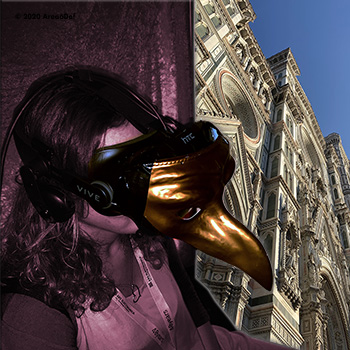L’Italia è un paese che difficilmente accetta di modificare o rinunciare alle sue tradizioni.
Leonardo Da Vinci, Michelangelo Buonarroti, Sandro Botticelli, Filippo Brunelleschi, sono “I Maestri del Rinascimento” che hanno contribuito alla nascita artistica di Firenze nel XV secolo.

Come possiamo riuscire, attraverso le nuove tecnologie, a valorizzare un territorio così antico, pieno di arte e cultura? Dobbiamo credere che importanti edifici, sculture, libri di carta, dipinti di grandi artisti siano ormai fuori moda, destinati all’estinzione?
Il mondo XR può diventare un mondo parallelo all’arte antica esposta in un museo? Un artista virtuale, che lavora con un visore e controller (tastierini portatili), può essere considerato un Michelangelo del futuro?
Siamo pronti per tutto questo?
Alcune aziende mirano a diffondere applicazioni in grado di “leggere” la Realtà Aumentata, inquadrando un’immagine che innesca e avvia una piccola animazione e fornisce informazioni aggiuntive.
Per la diffusione di massa di questa tecnologia, sono necessari bassi costi e una facilità d’uso che consenta alle persone di poter inserire le proprie immagini 2D, in un ambiente 3D molto limitato e con poche possibilità di modifica.
L’utente deve accettare di creare qualcosa su cui non ha ancora piena padronanza.
Saremo in grado di ottenere un ritorno economico dallo sviluppo che stiamo facendo oggi della Realtà Aumentata che non sia solo una speranza per il futuro?
Ho intervistato alcuni artisti che si occupano di realtà virtuale in tutto il mondo e ho visto i loro meravigliosi dipinti virtuali realizzati grazie a software specifici, visori e joypad speciali.
Il pubblico di quest’arte, è disposto a indossare un visore per entrare in questo mondo artistico.
Siamo sicuri che i visitatori dell’Accademia di Belle Arti di Firenze (Italia) sarebbero disposti a vedere il David di Michelangelo attraverso un visore? Cosa creano gli artisti della realtà virtuale? Possiamo sempre parlare di arte o dobbiamo separare il concetto e parlare di creatività digitale espressa in una modalità ancora sconosciuta a molti?
Il mondo XR è necessario per i creativi, ma non è stata ancora trovata una piattaforma che possa dare all’artista una maggiore libertà creativa.

Un artista davanti a una tela bianca, con pennelli e colori, può dipingere l’impensabile.
Nel mondo XR, vengono offerti ambienti programmati che non consentono alla persona creativa di inventare niente a cui il programmatore non avesse già pensato.
E se forniamo all’artista gli strumenti per sviluppare dei software che offrano gli strumenti necessari per la creazione di arte digitale, lo trasformiamo in un programmatore.
Come possono queste due figure collaborare insieme per sviluppare qualcosa di nuovo?
The evolution of culture, through the XR World
I live in Italy, a country that hardly accepts to modify or renounce its traditions.
Leonardo Da Vinci, Michelangelo Buonarroti, Sandro Botticelli, Filippo Brunelleschi, are “The Masters of the Renaissance” who contributed to the artistic birth of Florence in the 15th century.
How can we succeed, through new technologies, in enhancing such an ancient territory, full of art and culture? Are we to believe that important buildings, sculptures, paper books, paintings by great artists are now out of fashion, destined for extinction?
Can the XR World become a parallel world to ancient art exhibited in a museum? Can a virtual artist, who works with a viewer and controllers (handheld joypads), be considered a Michelangelo of the future? Are we ready for all this?
Some companies aim to spread applications that can “read” Augmented Reality, only by framing an image that triggers and starts a little animation with some additional information.
For the mass diffusion of this technology, it takes low costs and ease of use that allows people to upload their 2D images, in a very limited 3D environment and with little possibility of modification.
User agrees to create something over which he does not yet have full mastery.
Will we be able to get an economic return from the development we are doing today of Augmented Reality that it is not just a hope for the future?
I interviewed some Virtual Reality Artist, around the world, and I have seen their wonderful virtual paintings maked thanks to specific software, viewer and special joypads.
The audience of this art, is willing to wear a viewer to enter in this artistic world.
Are we sure that visitors to the Academy of Fine Arts in Florence (Italy) would be willing to see Michelangelo’s David through a viewer? What do Virtual Reality Artists create? Can we always talk about art or do we have to split the concept and talk about digital creativity that is expressed in a way that is still unknown to many?
XR World there is need for creatives, but a platform has not yet been found that can give the artist greater creative freedom.
An artist in front of a white canvas, with brushes and colors, can paint the unthinkable.
In the XR World, programmed environments are offered that do not allow the creative person to invent anything that the programmer has not already thought of.
And if we give the artist the tools to develop software that can provide the tools necessary for the creation of digital art, we transform him into a programmer.
How can these two figures work together to develop something new?
(Reference: https://immersivedirectory.com/the-evolution-of-culture-through-the-xr-world/)

